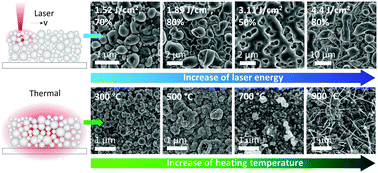Oxide rupture-induced conductivity in liquid metal nanoparticles by laser and thermal sintering†
Abstract
Metallic inks with superior conductivity and printability are necessary for high-throughput manufacturing of printed electronics. In particular, gallium-based liquid metal inks have shown great potential in creating soft, flexible and stretchable electronics. Despite their metallic composition, as-printed liquid metal nanoparticle films are non-conductive due to the surrounding metal oxide shells which are primarily Ga2O3, a wide-bandgap semiconductor. Hence, these films require a sintering process to recover their conductivity. For conventional solid metallic nanoparticles, thermal and laser processing are two commonly used sintering methods, and the sintering mechanism is well understood. Nevertheless, laser sintering of liquid metal nanoparticles was only recently demonstrated, and to date, the effect of thermal sintering has rarely been investigated. Here, eutectic gallium–indium nanoparticle films are processed separately by laser or thermal sintering in an ambient environment. Laser and thermally sintered films are compared with respect to electrical conductivity, surface morphology and elemental composition, crystallinity and surface composition. Both methods impart thermal energy to the films and generate thermal stress in the particles, resulting in rupture of the gallium oxide shells and achieving electrical conductivity across the film. For laser sintering, extensive oxide rupture allows liquid metal cores to flow out and coalesce into conductive pathways. For thermal sintering, due to less thermal stress and more oxidation, the oxide shells only rupture locally and extensive phase segregation occurs, leading to non-liquid particle films at room temperature. Electrical conductivity is instead attributed to segregated metal layers and gallium oxide which becomes crystalline and conductive at high temperatures. This comprehensive comparison confirms the necessity of oxidation suppression and significant thermal stress via instantaneous laser irradiation to achieve conductive patterns in liquid form.



 Please wait while we load your content...
Please wait while we load your content...